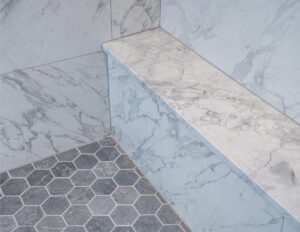What to Do First When Renovating a Bathroom: A No-BS Guide for Denver Homeowners
Hey there, fellow DIY warriors and design daydreamers! So, you’ve decided to tackle that bathroom renovation. Maybe your shower’s stuck in the ‘70s, or your tiles look like they’ve survived a zombie apocalypse. Whatever the reason, congrats—you’re about to embark on a journey that’s equal parts thrilling and slightly terrifying. But before you start swinging a sledgehammer like Thor at a demolition sale, let’s talk about the first steps that’ll save you time, money, and maybe your marriage (trust us, renovation stress is real).
Here at Verified Builders, Denver’s go-to home renovation company, we’ve seen it all—from Pinterest-perfect makeovers to “wait, why is there a toilet in the kitchen?” disasters. Let’s make sure your project leans toward the former.
Contents
- 1 Step 1: Assess Your Needs (Before You Swing That Sledgehammer)
- 2 Step 2: Set a Realistic Budget (Because Surprises Aren’t Always Fun)
- 3 Step 3: Find Your Style (Without Getting Lost on Instagram)
- 4 Step 4: Hire the Right Team (Or DIY… If You Dare)
- 5 Step 5: Plan for the Chaos (Because It’s Coming)
- 6 FAQ: Your Burning Questions, Answered
- 7 Final Thought: Trust the Process (and Maybe Us)
Step 1: Assess Your Needs (Before You Swing That Sledgehammer)
Raise your hand if you’ve ever gotten halfway through a project and realized… you forgot to plan for plumbing. Yeah, we’ve been there too. The first rule of bathroom renovations? Know what you’re working with. Ask yourself:
- Is this a quick refresh or a full gut job? Swapping fixtures is one thing; moving plumbing lines is another.
- Who’s using this space? A kid-friendly bath needs durability. A spa-like ensuite? Hello, heated floors.
- What’s your realistic timeline? Spoiler: It’ll probably take longer than you think.
Pro tip: Snap photos of your existing layout. Future You will thank Present You when you’re trying to remember where the pipes were. And if you’re feeling overwhelmed, Verified Builders offers design-build construction services—because guessing games are for trivia night, not renovations.
Step 2: Set a Realistic Budget (Because Surprises Aren’t Always Fun)
Let’s get real: budgets are like diets. Easy to start, hard to stick to. But here’s the thing—you need one, unless you enjoy eating ramen for a year to pay for that waterfall showerhead.
Break it down like this:
- Labor: 40–60% of your total cost (yes, really).
- Materials: Tile, fixtures, lighting—the fun stuff.
- Contingency Fund: 10–20% for “oh crap” moments (like discovering mold behind the drywall).
FYI, if you’re juggling multiple projects—say, a bathroom reno and kitchen remodeling services—whole home remodeling might save you cash long-term. We’ve helped Denver folks bundle projects to maximize efficiency (and sanity).
Step 3: Find Your Style (Without Getting Lost on Instagram)
Pinterest is a blessing and a curse. One minute you’re looking at subway tile, the next you’re debating gold-leaf ceilings. Stay focused!
- Browse, but set boundaries. Save 5–10 inspiration photos that actually match your space.
- Prioritize function. That floating vanity looks sleek… until you realize it offers zero storage.
- Mix high and low. Splurge on statement lighting but save with classic white tiles.
And hey, if you’re craving luxury home renovations but your wallet says “nope,” interior remodeling tricks like frameless mirrors or modern hardware can elevate the vibe without blowing the budget.
Step 4: Hire the Right Team (Or DIY… If You Dare)
Here’s where things get spicy. Should you DIY or call the pros? Let’s break it down:
| Task | DIY-Friendly? | Call the Pros? |
|---|---|---|
| Painting | ✅ Yes | ❌ No |
| Tile Installation | 🟡 Maybe | ✅ Yes (for complex patterns) |
| Plumbing/Electric | ❌ No | ✅ Absolutely |
Look, we get it—DIY projects can be rewarding. But unless you’re secretly a licensed plumber, leave the pipes to Verified Builders. We’re Denver’s trusted home addition contractors and basement contractors, and we’ve got your back. Plus, permits? Yeah, we handle those too.
Step 5: Plan for the Chaos (Because It’s Coming)
Renovations are messy. Like, “why is there dust in my coffee?” messy. Prep like a pro:
- Create a temporary bathroom setup. Ever tried showering at the gym for three weeks? It gets old fast.
- Protect your stuff. Cover furniture, seal off vents, and mentally prepare your pets.
- Communicate with your team. Daily check-ins prevent “wait, we were supposed to move the sink?” moments.
And if you’re tackling a custom home remodeling project, consider phasing the work. No one wants to live in a construction zone 24/7.
FAQ: Your Burning Questions, Answered
1. “How long does a bathroom reno take?”
Small refreshes: 1–2 weeks. Full gut jobs: 4–6 weeks (or longer if you’re adding home restoration elements like vintage fixtures).
2. “What adds the most value?”
Neutral finishes, efficient layouts, and quality materials. But IMO, heated floors are the unsung hero of resale.
3. “Can I keep my existing layout?”
Usually, yes—unless you’re dreaming of a double vanity. Moving plumbing = $$$.
4. “Why hire a home remodeling company instead of a handyman?”
Complex projects need permits, inspections, and expertise. Handymen are great for small fixes, but for design-build construction, go pro.
Final Thought: Trust the Process (and Maybe Us)
Renovating a bathroom is like assembling IKEA furniture—frustrating at times, but so worth it when you’re done. Whether you’re updating a powder room or tackling whole home remodeling, planning is everything. And if you hit a wall (literally or figuratively), Verified Builders is here to help. We’re Denver’s favorite home renovation company near me, and we’ve got the tools, talent, and dad jokes to make your project a success.
Ready to turn that bathroom nightmare into a dream space? Give us a shout. And hey, if you mention this article, we’ll throw in a free coffee—because everyone deserves a caffeine boost during renovations. ☕
Verified Builders: Your Denver partner for luxury home renovations, interior remodeling, and everything in between. Let’s build something awesome.


